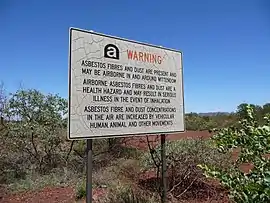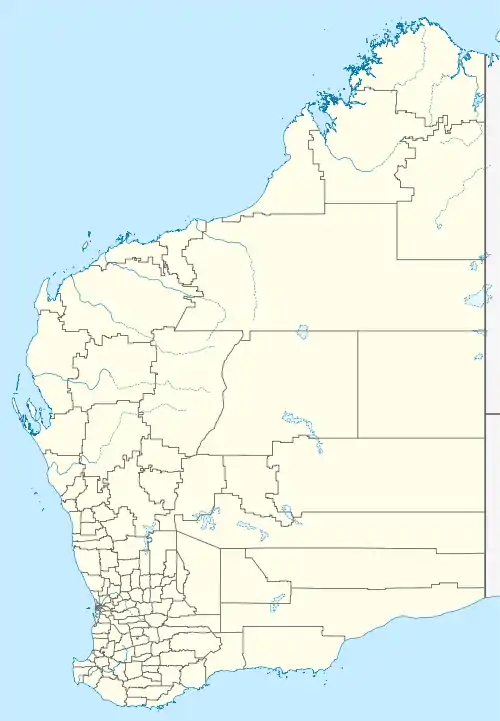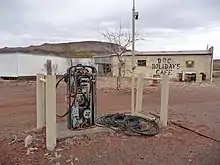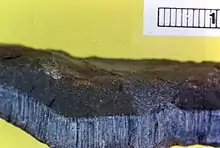Wittenoom, Western Australia
Wittenoom is a declared contaminated site and former townsite 1,420 kilometres (880 mi) north-north-east of Perth, in the Hamersley Range in the Pilbara region of Western Australia.[3][4] The declared contaminated site comprises 50,000 hectares (120,000 acres), making it the "largest contaminated site in the southern hemisphere."[5][6]
| Wittenoom Western Australia | |||||||||
|---|---|---|---|---|---|---|---|---|---|
 State government warning sign near the entrance to the former Wittenoom township. | |||||||||
 Wittenoom | |||||||||
| Coordinates | 22°14′23″S 118°20′05″E | ||||||||
| Population | 1 (2020)[1] | ||||||||
| Established | 1950[2] | ||||||||
| Gazetted | Degazetted June 2007 | ||||||||
| Postcode(s) | 6751 | ||||||||
| Location | 140 km (87 mi) from Tom Price | ||||||||
| LGA(s) | Shire of Ashburton | ||||||||
| State electorate(s) | North West Central | ||||||||
| Federal Division(s) | Durack | ||||||||
| |||||||||
The area around Wittenoom was mainly pastoral until the 1930s when mining for blue asbestos began in the area. By 1939, major mining began in Yampire Gorge, which was subsequently closed in 1943 when mining began in Wittenoom Gorge. In 1947 a company town was built, and by the 1950s it was the Pilbara's largest town. During the 1950s and early 1960s Wittenoom was Australia's only supplier of blue asbestos. The mine was shut down in 1966 due to unprofitability and growing health concerns from asbestos mining in the area.
The former townsite no longer receives government services. In December 2006, the Government of Western Australia announced that the town's official status would be removed, and in June 2007, Jon Ford, the Minister for Regional Development, announced that the townsite had officially been degazetted. The town's name was removed from official maps and road signs and the Shire of Ashburton is able to close roads that lead to contaminated areas.
The Wittenoom steering committee met in April 2013 to finalise closure of the town, limit access to the area and raise awareness of the risks. Details of how that would be achieved were to be determined but it would likely necessitate removing the town's remaining residents, converting freehold land to crown land, demolishing houses and closing or rerouting roads. By 2015 six residents remained; in 2017 the number dropped to four,[7] to three in 2018, and to one in 2019.
Name
Wittenoom was named by Lang Hancock after Frank Wittenoom, his partner in the nearby Mulga Downs Station. The land around Wittenoom was originally settled by Wittenoom's brother, politician Sir Edward Horne Wittenoom.[2] By the late 1940s there were calls for a government townsite near the mine, and the Mines Department recommended it be named Wittenoom, advising that adoption of this name was strongly urged by the local people. The name was approved in 1948, but it was not until 2 May 1950 that the townsite was officially gazetted.[8] In 1951 the name was changed to Wittenoom Gorge at the request of the mining company, and in 1974 it was changed back to Wittenoom. The mine closed in 1966, and the townsite was officially abolished by gazettal in March 2007.[2]
History
In 1917 the Mines Department first recorded the presence of blue asbestos in the Hamersley Ranges. Langley Hancock discovered Wittenoom Gorge on the Mulga Downs property in the early 1930s.[10] In 1937 Langley (Lang) Hancock showed samples of blue asbestos crocidolite that he had picked up in the Gorge to Islwyn (Izzy) Walters and Walter (Len) Leonard, who were at that time mining and treating white asbestos at Nunyerrie and at Lionel near Nullagine. When Hancock learned the fibre would fetch £70 per ton, he immediately pegged the best claims in Wittenoom Gorge. Leo Snell, a Kangaroo shooter on Mulga Downs, pegged a claim on Yampire Gorge, where there was a lot more blue asbestos. Walters and Leonard purchased Yampire Gorge from Snell and moved their treatment plant there and began mining and treating the fibre. When Leonard cabled London that there were two miles of asbestos in sight at Yampire Gorge, they cabled him back saying he should take a holiday. Leonard had to send a photograph before it was believed Yampire Gorge contained this much asbestos. Walters and Leonard cleared the way into Yampire Gorge by blasting the biggest rocks and pulling them out the way with a camel team. Even after that it took them seven hours to drive their lorry the 24 kilometres (15 mi) from the workings to their treatment plant. By 1940, twenty-two men were employed at the Yampire Gorge workings and about 375 tons were mined and transported to the coast (Point Samson) by mule team wagons. During the war, communications with England became difficult, and de Berrales acquired an interest in the mines. Finally in 1943 the Colonial Sugar Company through its subsidiary, Australian Blue Asbestos Ltd took over both the Wittenoom and Yampire Mines. Lang Hancock who watched his station property transform to a town stated in 1958: "Izzy Walters was the man who stuck it and produced the market that made Wittenoom of today possible." Walter's partner Len Leonard, put it this way in 1958: "but for his (Islwyn Walters) sheer grit and hard work there would be no such thing as Wittenoom. We have him to thank for that."
Please note this is about the text of this Wikipedia article; it should not be taken to reflect on the subject of this article.
Do not restore or edit the blanked content on this page until the issue is resolved by an administrator, copyright clerk or OTRS agent.
If you have just labeled this page as a potential copyright issue, please follow the instructions for filing at the bottom of the box.

The previous content of this page or section has been identified as posing a potential copyright issue, as a copy or modification of the text from the source(s) below, and is now listed at Copyright problems :
Temporarily, the original posting is still accessible for viewing in the page history.
- You must permit the use of your material under the terms of the Creative Commons Attribution-Sharealike 3.0 Unported License (CC BY-SA 3.0) and the GNU Free Documentation License (GFDL) (unversioned, with no invariant sections, front-cover texts, or back-cover texts).
- Explain your intent to license the content on this article's discussion page.
- To confirm your permission, you can either display a notice to this effect at the site of original publication or send an e-mail from an address associated with the original publication to permissions-en
 wikimedia.org or a postal letter to the Wikimedia Foundation. These messages must explicitly permit use under CC BY-SA and the GFDL. See Wikipedia:Donating copyrighted materials.
wikimedia.org or a postal letter to the Wikimedia Foundation. These messages must explicitly permit use under CC BY-SA and the GFDL. See Wikipedia:Donating copyrighted materials. - Note that articles on Wikipedia must be written from a neutral point of view and must be verifiable in published third-party sources; consider whether, copyright issues aside, your text is appropriate for inclusion in Wikipedia.
Your rewrite should be placed on this page, where it will be available for an administrator or clerk to review it at the end of the listing period. Follow this link to create the temporary subpage.
- Simply modifying copyrighted text is not sufficient to avoid copyright infringement—if the original copyright violation cannot be cleanly removed or the article reverted to a prior version, it is best to write the article from scratch. (See Wikipedia:Close paraphrasing.)
- For license compliance, any content used from the original article must be properly attributed; if you use content from the original, please leave a note at the top of your rewrite saying as much. You may duplicate non-infringing text that you had contributed yourself.
- It is always a good idea, if rewriting, to identify the point where the copyrighted content was imported to Wikipedia and to check to make sure that the contributor did not add content imported from other sources. When closing investigations, clerks and administrators may find other copyright problems than the one identified. If this material is in the proposed rewrite and cannot be easily removed, the rewrite may not be usable.
- Posting copyrighted material without the express permission of the copyright holder is considered copyright infringement, which is both illegal and against Wikipedia policy.
- If you have express permission, this must be verified either by explicit release at the source or by e-mail or letter to the Wikimedia Foundation. See Wikipedia:Declaration of consent for all enquiries.
- Policy requires that we block those who repeatedly post copyrighted material without express permission.
If you have tagged the article for investigation, please complete the following steps:
- Add the following to the bottom of Wikipedia:Copyright problems/2020 September 26:
* {{subst:article-cv|Wittenoom, Western Australia}} from https://web.archive.org/web/20090915105216if_/http://bizline.docep.wa.gov.au/safetyline/media/The%20wittenoom%20disaster%20review.pdf. ~~~~ - Place this notice on the talk page of the contributor of the copyrighted material:
{{subst:Nothanks-web|pg=Wittenoom, Western Australia|url=https://web.archive.org/web/20090915105216if_/http://bizline.docep.wa.gov.au/safetyline/media/The%20wittenoom%20disaster%20review.pdf}} ~~~~ - To hide a section instead of an entire article, add the template to the beginning of the section and {{Copyvio/bottom}} at the end of the portion you intend to blank.
Current situation
As of 2016 Wittennoom had only three permanent residents[13] who defy the Government of Western Australia's removal of services and stated intention to demolish the town. On 30 June 2006, the Government turned off the power grid to Wittenoom.[14][12]:22 There were still three as of late 2018, when the government introduced plans to force them out.[15]
A report by consultants GHD Group and Parsons Brinckerhoff in November 2006 evaluated the continuing risks associated with asbestos contamination in the town and surrounding areas and classed the risk to visitors as medium and to residents as extreme.[14][12]:22 In December 2006, Minister for the Pilbara and Regional Development Jon Ford announced that Wittenoom's status as a town would be removed, and in June 2007, he announced that the townsite status was officially removed.[16]
Both the Department of Health and an accredited contaminated sites auditor reviewed the report, with the latter finding that the detected presence of free asbestos fibres in surface soils from sampled locations presented an unacceptable public health risk. The auditor recommended that the former townsite and other impacted areas defined in the report be classified as "Contaminated - Remediation Required". The Department of Environment and Conservation subsequently classified Wittenoom as a contaminated site under the Contaminated Sites Act 2003 on 28 January 2008.[14][12]:22
However, opinion is not unanimous on the danger posed. Mark Nevill, a geologist and former Labor MLC for the Mining and Pastoral district, said in an interview in 2004 that the asbestos levels in the town were below the detection level of most equipment, and the real danger is located in the gorge itself which contains the mine tailings. Residents once operated a camping ground, guesthouse and gem shop for passing tourists. The roof of the gem shop is now caved in and the wood of the guest house is rotten, while the camping ground is nowhere to be found.[17][18]
It was reported in 2018 that thousands of travellers still visited the ghost town every year as a form of extreme tourism.[19]
The Australian Mesothelioma Registry (AMR) is another way that the Australian government is taking part in the fight against asbestos-related cancer. This national database keeps track of information about people who were diagnosed with mesothelioma after July 2010. It records all new cases in order to help the government develop policies on how to deal with asbestos that still remains in the country and reduce mesothelioma going forward.[20]
Please note this is about the text of this Wikipedia article; it should not be taken to reflect on the subject of this article.
Do not restore or edit the blanked content on this page until the issue is resolved by an administrator, copyright clerk or OTRS agent.
If you have just labeled this page as a potential copyright issue, please follow the instructions for filing at the bottom of the box.

The previous content of this page or section has been identified as posing a potential copyright issue, as a copy or modification of the text from the source(s) below, and is now listed at Copyright problems :
Temporarily, the original posting is still accessible for viewing in the page history.
- You must permit the use of your material under the terms of the Creative Commons Attribution-Sharealike 3.0 Unported License (CC BY-SA 3.0) and the GNU Free Documentation License (GFDL) (unversioned, with no invariant sections, front-cover texts, or back-cover texts).
- Explain your intent to license the content on this article's discussion page.
- To confirm your permission, you can either display a notice to this effect at the site of original publication or send an e-mail from an address associated with the original publication to permissions-en
 wikimedia.org or a postal letter to the Wikimedia Foundation. These messages must explicitly permit use under CC BY-SA and the GFDL. See Wikipedia:Donating copyrighted materials.
wikimedia.org or a postal letter to the Wikimedia Foundation. These messages must explicitly permit use under CC BY-SA and the GFDL. See Wikipedia:Donating copyrighted materials. - Note that articles on Wikipedia must be written from a neutral point of view and must be verifiable in published third-party sources; consider whether, copyright issues aside, your text is appropriate for inclusion in Wikipedia.
Your rewrite should be placed on this page, where it will be available for an administrator or clerk to review it at the end of the listing period. Follow this link to create the temporary subpage.
- Simply modifying copyrighted text is not sufficient to avoid copyright infringement—if the original copyright violation cannot be cleanly removed or the article reverted to a prior version, it is best to write the article from scratch. (See Wikipedia:Close paraphrasing.)
- For license compliance, any content used from the original article must be properly attributed; if you use content from the original, please leave a note at the top of your rewrite saying as much. You may duplicate non-infringing text that you had contributed yourself.
- It is always a good idea, if rewriting, to identify the point where the copyrighted content was imported to Wikipedia and to check to make sure that the contributor did not add content imported from other sources. When closing investigations, clerks and administrators may find other copyright problems than the one identified. If this material is in the proposed rewrite and cannot be easily removed, the rewrite may not be usable.
- Posting copyrighted material without the express permission of the copyright holder is considered copyright infringement, which is both illegal and against Wikipedia policy.
- If you have express permission, this must be verified either by explicit release at the source or by e-mail or letter to the Wikimedia Foundation. See Wikipedia:Declaration of consent for all enquiries.
- Policy requires that we block those who repeatedly post copyrighted material without express permission.
If you have tagged the article for investigation, please complete the following steps:
- Add the following to the bottom of Wikipedia:Copyright problems/2020 September 26:
* {{subst:article-cv|Wittenoom, Western Australia}} from https://web.archive.org/web/20090915105216if_/http://bizline.docep.wa.gov.au/safetyline/media/The%20wittenoom%20disaster%20review.pdf. ~~~~ - Place this notice on the talk page of the contributor of the copyrighted material:
{{subst:Nothanks-web|pg=Wittenoom, Western Australia|url=https://web.archive.org/web/20090915105216if_/http://bizline.docep.wa.gov.au/safetyline/media/The%20wittenoom%20disaster%20review.pdf}} ~~~~ - To hide a section instead of an entire article, add the template to the beginning of the section and {{Copyvio/bottom}} at the end of the portion you intend to blank.
Legacy

The 1990 Midnight Oil song, "Blue Sky Mine" and its album Blue Sky Mining, was inspired by the town and its mining industry,[21] as were He Fades Away and Blue Murder by Alistair Hulett. The town and its history are also featured in the novel Dirt Music by Tim Winton.
Digital poet Jason Nelson created the work Wittenoom: speculative shell and the cancerous breeze, an interactive exploration of the town's death. It won the Newcastle Poetry Prize in 2009.[22]
References
- Zaunmayr, Tom (2 February 2018). "Group gives rare glimpse into Wittenoom's heyday". The West Australian. Retrieved 30 October 2020.
- Western Australian Land Information Authority. "History of country town names – W". Retrieved 10 September 2007.
- "Prohibited Areas – Wittenoom and Yampire Gorge" (PDF). Shire of Ashburton. 2019. Retrieved 16 July 2019.
- "Closure of former Wittenoom Townsite Roads". Shire of Ashburton (News). Western Australia. 9 May 2019. Retrieved 16 July 2019.
- Macmath, Antoine (11–13 November 2019). Keynote discussion: The Wittenoom legacy (PDF). Asbestos Safety 2019 Conference. Perth, Western Australia. pp. 4–16. Retrieved 22 September 2020.
- Foster, Ally (21 July 2019). "Tourists flock to 'Australia's Chernobyl' despite health risks". news.com.au. Surry Hills. Retrieved 26 September 2020.
- Croy, Liam (2 January 2017). "It may be a ghost town but for some Wittenoom is home". The West Australian. Perth. Retrieved 26 September 2020.
- "Western Australian Government Gazette 42, 1950 Page 974" (PDF). State Law Publisher. Retrieved 15 November 2010.
- "Place No. 60 St Paul's Catholic Church Karratha" (PDF). City of Karratha. Shire of Roebourne. 2012. Retrieved 26 September 2020.
- Edmonds, Jack (25 July 1958). "North-West Pioneer lived in a packing Case". Daily News. Perth. ISSN 1839-8146.
- Hills, Ben (1989). Blue Murder: Two Thousand Doomed to Die: the Shocking Truth about Wittenoom's Deadly Dust. South Melbourne: Sun Books. ISBN 9780725105815.
- Snell, Beryl; Langley, Jeffrey (2009). The Wittenoom Disaster (PDF) (Report). West Perth: WorkSafe, Department of Commerce, Government of Western Australia. Archived from the original (PDF) on 15 September 2009. Retrieved 14 November 2010.
- Garrick, Melanie; Florance, Loretta (18 November 2016). "Wittenoom: The survivors of an erased town". Australian Broadcasting Corporation. Retrieved 26 September 2020.
- Department of Environment and Conservation. "Search for Known Contaminated Sites". Retrieved 14 November 2010.
- Michelmore, Karen (20 March 2019). "Wittenoom residents to be forced out as frustration boils over in effort to close deadly site". Retrieved 5 January 2020.
- "New report into Wittenoom's asbestos risks". Regional Development Minister Jon Ford - Government of Western Australia. Archived from the original on 11 March 2012. Retrieved 14 November 2010.
- O'Donnell, Mick (6 December 2004). "Wittenoom's diehard residents stay put". The 7.30 Report. Archived from the original on 24 March 2017. Retrieved 15 February 2008.
- Fildes, Andrew (2006). "The Doom of Wittenoom". www.pbase.com. Retrieved 30 October 2020.
- De Poloni, Gian (12 July 2018). "Tourists warned over visiting asbestos-riddled Wittenoom, Australia's most dangerous ghost town". ABC News. Australian Broadcasting Corporation. Retrieved 30 October 2020.
- Sasser, Rachel (26 February 2017). "Asbestos Issues and Mesothelioma in Australia". mesowatch.com. Retrieved 30 October 2020.
- "Blue Sky Mine by Midnight Oil". Songfacts. 2020. Retrieved 30 October 2020.
- Nelson, Jason. "Curriculum Vitae" (PDF). Retrieved 30 October 2020.
Bibliography
- Glossop, Laurie (11–13 November 2019). Wittenoom Geology and History (PDF). Asbestos Safety 2019 Conference. Perth, Western Australia. pp. 19–39. Retrieved 22 September 2020.
External links
| Wikimedia Commons has media related to Wittenoom, Western Australia. |
- Wittenoom: Asbestos contamination and management (Western Australian Government)
- The Asbestos Disease Society of Australia


